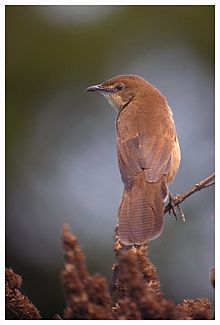Broad-tailed grassbird
| Broad-tailed grassbird | |
|---|---|
 |
|
| Scientific classification | |
| Kingdom: | Animalia |
| Phylum: | Chordata |
| Class: | Aves |
| Order: | Passeriformes |
| Family: | Locustellidae |
| Genus: | Schoenicola |
| Species: | S. platyurus |
| Binomial name | |
|
Schoenicola platyurus Jerdon, 1844 |
|
| Synonyms | |
|
Timalia platyura |
|
Timalia platyura
The broad-tailed grassbird (Schoenicola platyurus) is a species of Old World warbler in the Locustellidae family. It is endemic to the Western Ghats of India with the possibility of occurrence in Sri Lanka, with few doubtful records. A small, mostly brown bird, it has a broad rounded and graduated tail. It is found only on the higher altitude grassy hills where it usually skulks, except during the breeding season when males fly up into the air to sing in their display. The species is believed to be a resident although it is possible that they make local movements.
The uniform brown upperparts, broad and long graduated tail of the bird is distinctive. The species has a buff supercilium and the brown tail has thin dark bars. The underside of the tail is very dark and the feathers are tipped with white. Males and females are indistinguishable in plumage. The call of the male during breeding is a lark-like and repeated trill that is accompanied by fanned tail and a fluttering flight. Other calls include a chack and a zink note. The gape colour is black and visible in singing males but is brown in females. In the non-breeding season, it is a skulker moving rapidly between grass and reeds but sometimes perches in the open.
The species has in former times included the African Schoenicola brevirostris which was originally called Catriscus apicalis and later as Schoenicola platyura brevirostris. The Indian species was first described by Jerdon who found the bird at the base of the Gudalur ghat at the foothills of the Nilgiris. The bill is short strong and culmen is slightly curved in the genus and there are two rictal bristles. The tarsus is somewhat long for the proportions. The populations north and south of the Palghat gap are said to differ in plumage shade, the northern form being larger and paler and greyer above with the flanks sandy-brown. The southern form is dark rufous brown above and more whitish below with bright buff on the breast and flanks. This plumage variation was earlier believed to be seasonal. Molecular phylogeny studies place the genus in the warbler subfamily Megalurinae (along with Megalurus, Chaetornis and Graminicola).
...
Wikipedia

